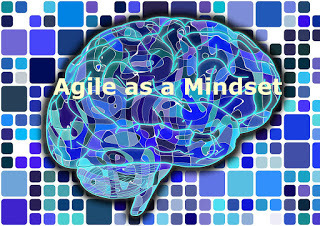CIO Master Book Preview Chapter 9 IT Agility
Agile is the "State of Mind"
 Agility is not only the ability to create changes, but also the capability to adapt to changes. Within IT, organizational agility should be defined as the speed in which the organization can enable the enterprise's goals and objectives. IT agility is about how IT will enable business agility, how fast IT will deliver he required products and services effectively and efficiently. The more integral business and IT become, the higher level of agility for both will be achieved.
Agility is not only the ability to create changes, but also the capability to adapt to changes. Within IT, organizational agility should be defined as the speed in which the organization can enable the enterprise's goals and objectives. IT agility is about how IT will enable business agility, how fast IT will deliver he required products and services effectively and efficiently. The more integral business and IT become, the higher level of agility for both will be achieved.
Agile is the set of guidelines: In order for any methodology to be truly agile, it must be adaptive. That is, there should be regular reflection and updates to the methodology to eliminate what does not work and try things that might work. It is important to recognize that moving to Agile may require a significant culture change that require affects the entire business. It is certainly not just a ‘development thing.’ Agile is a set of principles, but it also comes from many different groups of practices finding common ground. Principles alone are not enough. You also need to develop a set of “practices” to improve agility and increase quality. You are not agile until your practices match your principles, as they can not be separated completely.
Agility requires a set of complementary and strategic IT competencies: It includes but not limited to portfolio management, project management, change management, etc. there should be a rolling plan in addition to the mid-term or long-term strategic planning. The business need for agility arises due to changes in underlying assumptions. If these changes are captured in the rolling plan, flexibility can be achieved. The purpose of building an Agile IT is to pursue an optimal way running IT, to enable business innovation and transformation via taking advantage of the organization’s resources, and cultivate a set of necessary and unique business capabilities to gain competitive business advantage.
 Agile is better at adapting to changes and ensuring quality: Agile development techniques focus on solving the problems that arise because the customer’s needs evolve over time. And software development takes time, so any process that doesn’t account for changing needs or requirement can only produce a product that is meeting an outdated set of needs, usually to a bad result. So the CIO’s agile way is to run IT as a software startup, includes quick iteration, continuous improvement, and regular delivery because it’s the most effective way to remove risk and deliver quality software. CIO’s agile way is to be able to be equipped with the agile mindset, make strategic decisions and change directions more promptly, it allows IT leader to run IT as a business, treat software as a strategic asset, improve the success rate and manage IT with agility.
Agile is better at adapting to changes and ensuring quality: Agile development techniques focus on solving the problems that arise because the customer’s needs evolve over time. And software development takes time, so any process that doesn’t account for changing needs or requirement can only produce a product that is meeting an outdated set of needs, usually to a bad result. So the CIO’s agile way is to run IT as a software startup, includes quick iteration, continuous improvement, and regular delivery because it’s the most effective way to remove risk and deliver quality software. CIO’s agile way is to be able to be equipped with the agile mindset, make strategic decisions and change directions more promptly, it allows IT leader to run IT as a business, treat software as a strategic asset, improve the success rate and manage IT with agility.
The overall goal of adopting a more “Agile” approach is “resilience”: to increase value received and decrease risks. An agile organization at any scale that can retain an overall sense of vision and purpose, can communicate effectively, continuously improve, reflect on its own limitations, respond to change dynamically. It is a journey from “doing Agile,” to “being agile.”Follow us at: @Pearl_Zhu
 Agility is not only the ability to create changes, but also the capability to adapt to changes. Within IT, organizational agility should be defined as the speed in which the organization can enable the enterprise's goals and objectives. IT agility is about how IT will enable business agility, how fast IT will deliver he required products and services effectively and efficiently. The more integral business and IT become, the higher level of agility for both will be achieved.
Agility is not only the ability to create changes, but also the capability to adapt to changes. Within IT, organizational agility should be defined as the speed in which the organization can enable the enterprise's goals and objectives. IT agility is about how IT will enable business agility, how fast IT will deliver he required products and services effectively and efficiently. The more integral business and IT become, the higher level of agility for both will be achieved.
Agile is the set of guidelines: In order for any methodology to be truly agile, it must be adaptive. That is, there should be regular reflection and updates to the methodology to eliminate what does not work and try things that might work. It is important to recognize that moving to Agile may require a significant culture change that require affects the entire business. It is certainly not just a ‘development thing.’ Agile is a set of principles, but it also comes from many different groups of practices finding common ground. Principles alone are not enough. You also need to develop a set of “practices” to improve agility and increase quality. You are not agile until your practices match your principles, as they can not be separated completely.
Agility requires a set of complementary and strategic IT competencies: It includes but not limited to portfolio management, project management, change management, etc. there should be a rolling plan in addition to the mid-term or long-term strategic planning. The business need for agility arises due to changes in underlying assumptions. If these changes are captured in the rolling plan, flexibility can be achieved. The purpose of building an Agile IT is to pursue an optimal way running IT, to enable business innovation and transformation via taking advantage of the organization’s resources, and cultivate a set of necessary and unique business capabilities to gain competitive business advantage.
 Agile is better at adapting to changes and ensuring quality: Agile development techniques focus on solving the problems that arise because the customer’s needs evolve over time. And software development takes time, so any process that doesn’t account for changing needs or requirement can only produce a product that is meeting an outdated set of needs, usually to a bad result. So the CIO’s agile way is to run IT as a software startup, includes quick iteration, continuous improvement, and regular delivery because it’s the most effective way to remove risk and deliver quality software. CIO’s agile way is to be able to be equipped with the agile mindset, make strategic decisions and change directions more promptly, it allows IT leader to run IT as a business, treat software as a strategic asset, improve the success rate and manage IT with agility.
Agile is better at adapting to changes and ensuring quality: Agile development techniques focus on solving the problems that arise because the customer’s needs evolve over time. And software development takes time, so any process that doesn’t account for changing needs or requirement can only produce a product that is meeting an outdated set of needs, usually to a bad result. So the CIO’s agile way is to run IT as a software startup, includes quick iteration, continuous improvement, and regular delivery because it’s the most effective way to remove risk and deliver quality software. CIO’s agile way is to be able to be equipped with the agile mindset, make strategic decisions and change directions more promptly, it allows IT leader to run IT as a business, treat software as a strategic asset, improve the success rate and manage IT with agility.The overall goal of adopting a more “Agile” approach is “resilience”: to increase value received and decrease risks. An agile organization at any scale that can retain an overall sense of vision and purpose, can communicate effectively, continuously improve, reflect on its own limitations, respond to change dynamically. It is a journey from “doing Agile,” to “being agile.”Follow us at: @Pearl_Zhu
Published on April 04, 2016 23:20
No comments have been added yet.



